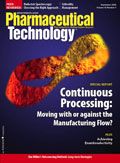A Catalyst for Environmental Consciousness
A recent book shows the links between synthesis, catalysis, and environmental protection.
Active pharmaceutical ingredients (APIs) are traditionally chemical moieties synthesized according to the principles of organic medicinal chemistry. The constant demand for isolating commercial quantities of therapeutic moieties challenges the scientific community's ability to preserve the environment.

Catalysis: Concepts and Green Applicationsby Gadi Rothenberg, Wiley, Hoboken, NJ,2008, 292 pp., ISBN: 978-3-527-31824-7
Green chemistry provides a means to produce needed APIs without unduly damaging the environment. Manufacturers can realize the environmental and economic benefits of green chemistry by using the US Environmental Protection Agency's principles, which include designing efficient synthetic methods, using nontoxic compounds and solvents, implementing safe chemical syntheses, using renewable feedstocks, developing biodegradable concepts, maximizing recovery, and choosing catalysts instead of stoichiometric reagents.
The book Catalysis: Concepts and Green Applications shows the reader the interrelations between the manufacturing processes for APIs, the role of catalysis, and green chemistry. It is a useful text for pharmaceutical scientists and API manufacturers because it explains the basic principles of green chemistry and the ways it protects the environment.
The book's introductory chapter examines product and process life cycle assessment, the importance of catalysis, catalysis, and three main catalytic processes. The author also compares stoichiometric reactions with catalytic cycles in an industrial setting and provides examples as illustrations.
This chapter's overview of catalytic processes is particularly helpful and should inspire scientists to use catalysis to mediate or enhance the synthesis of bulk pharmaceuticals and intermediates. Chapter 2 explains the fundamentals of sustainable chemistry and the basics of catalysis. A detailed discussion of reaction kinetics includes rates, reaction orders, rate-determining steps, Langmuir–Hinshelwood kinetics, the steady-state approximation and Michaelis–Menten kinetics, practical approaches in kinetic studies, initial reactions and concentration effects, and stoichiometric experiments.
The second chapter also reviews concepts such as catalysis–substrate interactions, catalyst deactivation, sintering and thermal degradations, catalysis inhibition, and catalyst poisoning. The author introduces readers to the principles of reaction kinetics and the factors that influence reaction rates. This knowledge helps professionals select and use the appropriate catalysts when they design effective synthetic methods.
The applications of metal-complex catalysis in the liquid phase are examined in Chapter 3, along with concepts of ligand exchanges. This chapter is particularly pertinent because it illustrates that every catalytic cycle is a sequence of simple chemical reactions such as adsorption, desorption, oxidative addition, reductive elimination, and nucleophilic attack. This principle clarifies the role of metal ions in catalyzing various chemical reactions.
The author also discusses catalysis without metals, classical acid–base catalysis, organocatalysis, catalyst recovery, and recycling techniques.
Chapter 4 explores classic gas–solid systems, the concepts of active-site and model-catalyst systems, and catalyst characterization. Topics such as liquid– solid and liquid–liquid catalytic systems, aqueous biphasic catalysis, phase-transfer catalysis, and advanced process solutions using heterogeneous catalysis are addressed. This chapter also presents applications of bulk and impregnated catalysts.
The reader learns the basics of enzyme catalysis in Chapter 5, along with its terms and definitions, the concept of active sites and substrate-binding models with the common mechanism of enzyme catalysis, intramolecular reactions and proximity effects, the applications of enzyme catalysis, the development of new biocatalysis, and nonenzyme catalysis. Industrial examples such as the chemoenzymatic synthesis of glycolic acid (a compound used in skin-care products), aspartame, and the synthesis of ampicillin, amoxicillin, and cephalexin help pharmaceutical professionals appreciate and understand proven catalytic processes mediated by enzymes.
The ways computers can aid catalysis are delineated in Chapter 6. The author describes using computers to help research, to create predictive models of catalysts, and to test hypotheses about catalytic cycles. In addition, the author reviews rational catalyst design and gives an overview of data-mining methods in catalysis and the optimization of catalytic processes in industry.
This book will help graduate students and pharmaceutical scientists and technologists enhance their understanding of green-chemistry applications and their implications for the environment. It is a useful resource for professionals seeking synthetic methods that are efficient and environmentally benign.
Ram Murty is the president of Murty Pharmaceuticals and a member of Pharmaceutical Technology's Editorial Advisory Board, 518 Codell Dr., Lexington, KY 40509.

Drug Solutions Podcast: A Closer Look at mRNA in Oncology and Vaccines
April 30th 2024In this episode fo the Drug Solutions Podcast, etherna’s vice-president of Technology and Innovation, Stefaan De Koker, discusses the merits and challenges of using mRNA as the foundation for therapeutics in oncology as well as for vaccines.
Pharmaceutical Tariffs Are Imminent: How Industry is Bracing for Impact
April 16th 2025On April 14, 2025, the Trump Administration launched a national security-driven investigation into pharmaceuticals, a move that will likely result in tariffs being placed on pharmaceutical drugs, ingredients, and other components that are imported from outside of the United States.